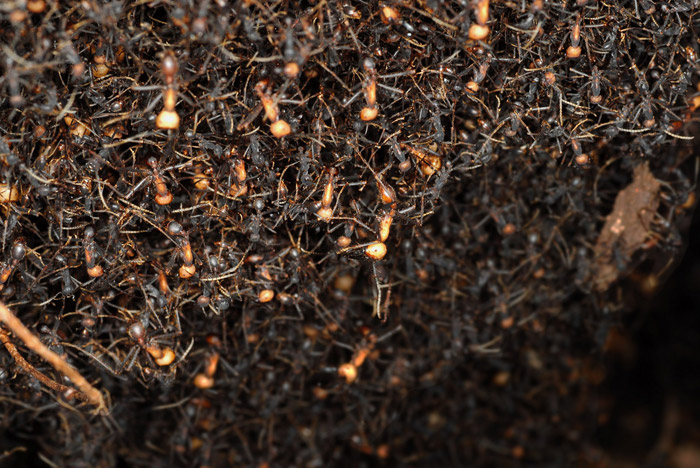© Arthur Chapman
An introduction to army ants
There are over 200 different known species of army ant. Eciton burchellii is one of the most studied species, and has typical army ants characteristics.
They are very aggressive and can tackle among some of the largest prey. They rest in temporary nests made entirely of ants, also known as a ‘bivouac‘. The queen ant and her brood stay safe in the centre of the mass of ants. The colony moves at night to its next location which could be up-to 200 yards away at speeds of 20 yards/hour.
At dawn, the workers spread out into a fan shaped swarm raiding almost all life in their way. They travel around 100 – 200 meters on their raiding days. Lead workers leave a chemical trail for others to follow. Smaller workers lead the column, while the major workers protect the flanks.
The entire colony can relocate to a new nesting site when they need a fresh food supply. Army ant colonies move in such large numbers that they can be heard marching along the forest floors. Sometimes workers connect together to make ‘ant bridges’ so that the army can flow faster over cracks, holes and even flowing streams.
The male drone ants are known as ‘sausage ants’ because of their large size and sausage shape.
Scientific names
Eciton burchellii, mostly Ecitoninae sp sp.
Distribution
Army ants can be found in the tropics and subtropics of Brazil, Peru and Mexico.
Habitat
Army ants are normally found in hot and humid lowland tropical rain forests. Their nests are typically found at the base of tree trunks.
Diet
Mostly insects including tarantulas, scorpions, beetles and other ant species all in large amounts. The occasional mammal including frogs, snakes and lizards.
Colony size
Established colonies may be found with between 150 thousand to 2 million individuals.
Queen
Unlink most queens, army ant queens are born without wings. They are large queens that change size depending if she is relocating to a new nest or not. She can lay up to 30,000 eggs each day. The queen and her colony can live between 10-20 years. Monogyn (one queen per colony).
Minor workers
Minor army ant workers are typically between 3-7mm. Dark ants with orange abdomens. Workers generally live for about 1 year.
Major workers / soldiers
Army ants are polymorphic and have major castes which are typically 10-12mm long. They are pale orange heads, dark orange legs and dark oversized mandibles. Take a look at the GigaPan link below, here you can really zoom in on one of these extreme looking ants.
Risk
Army ants are aggressive, and have a very strong bite. They have a serious impact on the native insects that cross their paths.
Pet info
You would have to be mad to have army ants as a pet!











